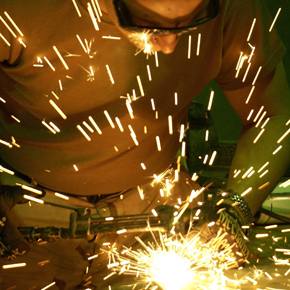
Construction equipment and legislation: Staying safe
Construction is one of the most dangerous industries in the UK; with 35 fatal injuries to workers in the sector in the last year alone. This is why stringent health and safety measures, as well as safety standards, are in place to protect workers and minimise risks.
Plant and construction equipment specialist Eros Hire Tools Limited has provided a summary of areas current legislation covers, and what the standard expectations are for equipment.
Health and safety law
Construction professionals are expected to be trained well enough to operate equipment with an acceptable level of competence.
It is the employer’s responsibility to ensure that workers comply with health and safety regulations, by having the appropriate knowledge, experience and ability to use the equipment properly.
The operation of mobile plant equipment is one of the most common causes of accidental death and injury on construction sites in the UK; ground is often uneven and muddy, and the large nature of equipment driver’s visibility is often obstructed.
It is essential that proper training is given in these circumstances; legislation states that sufficient training must be given to safely operate all equipment, and some areas even require specialist training.
For instance, LOLER training (in line with the Lifting Operations and Lifting Equipment Regulations 1998) ensures awareness of safe ways to operate machinery such as access platforms.
Equipment safety standards
In addition to the standards and legislation controlling safe operation of equipment, CE standards are designed to control safety at the product manufacturing stage.
The expansion of mandatory use of CE marking standards has slowly been increasing through industrial sectors. In September 2013, CE marking became mandatory for industrial doors and fire doors, and there has been a huge push over recent months on clearer classification of steel imports for the construction industry.
Whilst not all construction equipment and machinery requires a CE mark (for example, manually powered machinery), a number of products do currently fall under the product supply directives, making marking a legal requirement.
This includes powered machinery, pressure equipment and low-voltage electrical equipment.
The HSE has published a guide for industry professionals responsible for buying new machinery, which can be read in full here, in addition to an FAQ on EU product supply Directives.
Find out more about Eros Tools Hire
Latest news

19th April 2024
ASSA ABLOY: Access solutions can impact sustainability performance across the full life-cycle of a building
Embedding sustainability within any organisation requires a broad, strategic perspective. Scrutiny should include the physical infrastructure itself: According to the IEA, buildings consume around 30% of global energy*. ASSA ABLOY has more…
Posted in Access Control & Door Entry Systems, Architectural Ironmongery, Articles, Building Industry News, Building Products & Structures, Building Regulations & Accreditations, Building Services, Case Studies, Doors, Facility Management & Building Services, Information Technology, Research & Materials Testing, Retrofit & Renovation, Security and Fire Protection, Sustainability & Energy Efficiency, Video of the Week
19th April 2024
British weather doesn't dampen spirit for new HMG Garden Paint
Despite one of the wettest starts to the year on record, customers are starting to plan for brighter days with HydroPro Garden Paint from HMG Paints.
Posted in Articles, Building Industry News, Building Products & Structures, Garden, Innovations & New Products, Paints, Paints, Coatings & Finishes, Restoration & Refurbishment, Retrofit & Renovation, Site Preparation, Sustainability & Energy Efficiency, Waste Management & Recycling
18th April 2024
Abloy UK showcases new digital portfolio at The Security Event 2024
Abloy UK is set to unveil its latest line-up of access control systems at The Security Event 2024, welcoming guests to explore its cutting-edge electromechanical and digital solutions on stand 5/F50.
Posted in Access Control & Door Entry Systems, Architectural Ironmongery, Articles, Building Industry Events, Building Industry News, Building Products & Structures, Building Services, Doors, Exhibitions and Conferences, Facility Management & Building Services, Health & Safety, Information Technology, Retrofit & Renovation, Security and Fire Protection
18th April 2024
Strand is a Failsafe Choice for Emergency Exit and Panic Hardware
In times of emergency, you’re in safe hands with Strand Hardware. Although there are many considerations for building specification, few decisions can be as critical as selecting the right emergency exit/panic hardware.
Posted in Access Control & Door Entry Systems, Architectural Ironmongery, Articles, Building Industry News, Building Products & Structures, Building Services, Doors, Facility Management & Building Services, Health & Safety, Restoration & Refurbishment, Retrofit & Renovation, Security and Fire Protection
 Sign up:
Sign up: